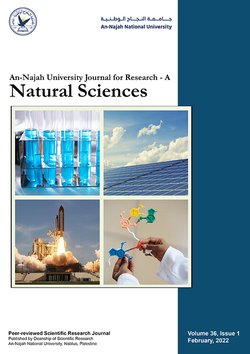The Response of Three Varieties of Wheat to Nitrogen Fertilization
Authors:
Article info
1997-10-06
1998-07-19
1998-07-19
55 - 69
Keywords
Abstract
The effects of different levels of nitrogen fertilization (0, 2, 4, 8 and 16 kg N / dunum) on the production of three wheat varieties (780, Lakeesh and Anbar) were studied. The experiment was conducted for two successive seasons 1994 and 1995. In the second season (1995) a higher nitrogen fertilization rate (16 kg N / dunum) and a third variety (Anbar) were added. The different levels of nitrogen fertilization were arranged in a Completely Randomized Design for each variety. The results showed positive response of the three varieties to the nitrogen fertilization. Nitrogen fertilization increased significantly the total yield and the straw weight in variety 780 and the grain weight for lakeesh variety in the first season. In the second season, there was a significant quadratic relation between the nitrogen fertilization and the total grain and straw weight in variety 780 and the total and grain weight for lackeesh, however for Anbar variety a significant quadratic relation was only shown between the nitrogen application and straw weight. There was no significant effect of nitrogen fertilization on grain size or the level of nitrogen and protein in the grains. Using the yield-fertilizer application relations obtained in the experiment, it was found that the optimal nitrogen fertilization which gave the highest (optimal) return were 5.7, 12.6 and 9.5 kg dunum for the three varieties (lakeesh, 780 and Anbar) subsequently. The optimal amount of fertilization wasn't highly influenced with 20% changes in prices.
Abu-Qaoud, H., & Mizyed, N. (1998). The Response of Three Varieties of Wheat to Nitrogen Fertilization. An-Najah University Journal for Research - A (Natural Sciences), 12(1), 55–69. https://doi.org/10.35552/anujr.a.12.1.386
[1]H. Abu-Qaoud and N. Mizyed, “The Response of Three Varieties of Wheat to Nitrogen Fertilization,” An-Najah University Journal for Research - A (Natural Sciences), vol. 12, no. 1, pp. 55–69, Jan. 1998, doi: 10.35552/anujr.a.12.1.386.
Abu-Qaoud, Hassan, and Numan Mizyed. “The Response of Three Varieties of Wheat to Nitrogen Fertilization.” An-Najah University Journal for Research - A (Natural Sciences), vol. 12, no. 1, Jan. 1998, pp. 55–69. Crossref, https://doi.org/10.35552/anujr.a.12.1.386.
1.Abu-Qaoud H, Mizyed N. The Response of Three Varieties of Wheat to Nitrogen Fertilization. An-Najah University Journal for Research - A (Natural Sciences) [Internet]. 1998 Jan;12(1):55–69. Available from: http://dx.doi.org/10.35552/anujr.a.12.1.386
Abu-Qaoud, Hassan, and Numan Mizyed. “The Response of Three Varieties of Wheat to Nitrogen Fertilization.” An-Najah University Journal for Research - A (Natural Sciences) 12, no. 1 (January 1998): 55–69. https://doi.org/10.35552/anujr.a.12.1.386.
استجابة ثلاثة أصناف من القمح للتسميد النيتروجيني
المؤلفون:
معلومات المقال
1997-10-06
1998-07-19
1998-07-19
55 - 69
الكلمات الإفتتاحية
الملخص
The effects of different levels of nitrogen fertilization (0, 2, 4, 8 and 16 kg N / dunum) on the production of three wheat varieties (780, Lakeesh and Anbar) were studied. The experiment was conducted for two successive seasons 1994 and 1995. In the second season (1995) a higher nitrogen fertilization rate (16 kg N / dunum) and a third variety (Anbar) were added. The different levels of nitrogen fertilization were arranged in a Completely Randomized Design for each variety. The results showed positive response of the three varieties to the nitrogen fertilization. Nitrogen fertilization increased significantly the total yield and the straw weight in variety 780 and the grain weight for lakeesh variety in the first season. In the second season, there was a significant quadratic relation between the nitrogen fertilization and the total grain and straw weight in variety 780 and the total and grain weight for lackeesh, however for Anbar variety a significant quadratic relation was only shown between the nitrogen application and straw weight. There was no significant effect of nitrogen fertilization on grain size or the level of nitrogen and protein in the grains. Using the yield-fertilizer application relations obtained in the experiment, it was found that the optimal nitrogen fertilization which gave the highest (optimal) return were 5.7, 12.6 and 9.5 kg dunum for the three varieties (lakeesh, 780 and Anbar) subsequently. The optimal amount of fertilization wasn't highly influenced with 20% changes in prices.
Abu-Qaoud, H., & Mizyed, N. (1998). The Response of Three Varieties of Wheat to Nitrogen Fertilization. An-Najah University Journal for Research - A (Natural Sciences), 12(1), 55–69. https://doi.org/10.35552/anujr.a.12.1.386
[1]H. Abu-Qaoud and N. Mizyed, “The Response of Three Varieties of Wheat to Nitrogen Fertilization,” An-Najah University Journal for Research - A (Natural Sciences), vol. 12, no. 1, pp. 55–69, Jan. 1998, doi: 10.35552/anujr.a.12.1.386.
Abu-Qaoud, Hassan, and Numan Mizyed. “The Response of Three Varieties of Wheat to Nitrogen Fertilization.” An-Najah University Journal for Research - A (Natural Sciences), vol. 12, no. 1, Jan. 1998, pp. 55–69. Crossref, https://doi.org/10.35552/anujr.a.12.1.386.
1.Abu-Qaoud H, Mizyed N. The Response of Three Varieties of Wheat to Nitrogen Fertilization. An-Najah University Journal for Research - A (Natural Sciences) [Internet]. 1998 Jan;12(1):55–69. Available from: http://dx.doi.org/10.35552/anujr.a.12.1.386
Abu-Qaoud, Hassan, and Numan Mizyed. “The Response of Three Varieties of Wheat to Nitrogen Fertilization.” An-Najah University Journal for Research - A (Natural Sciences) 12, no. 1 (January 1998): 55–69. https://doi.org/10.35552/anujr.a.12.1.386.

Since 2019
Cite Score (Scopus): 0.8
Time to First Decision: 5 Days
Submission to Acceptance: 90 Days
Acceptance to Publication: 14 Days
Acceptance Rate: 22%
Call for Papers:
Sustainable Materials and Chemistry for Energy and Environmental Applications
Why should you
Publish With Us?
An-Najah National University
Nablus, Palestine
Nablus, Palestine
- P.O. Box
- 7, 707
- Fax
- (970)(9)2345982
- Tel.
- (970)(9)2345560
- (970)(9)2345113/5/6/7-Ext. 2628
- [email protected]
- EIC
- Prof. Waleed Sweileh
An-Najah University Journal for Research - A (Natural Sciences) by An-Najah University, Nablus, Palestine is licensed under CC BY-NC 4.0

